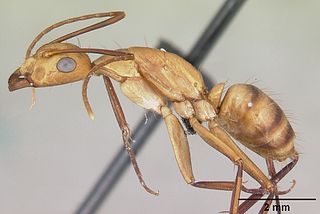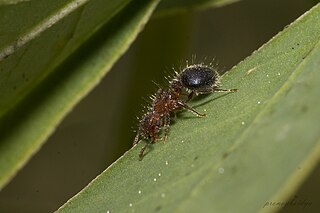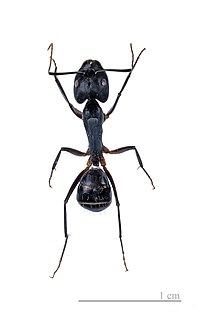
Nylanderia is a large genus of ants in the subfamily Formicinae. The genus has a nearly cosmopolitan distribution with species inhabiting a wide array of habitats in almost all geographic regions. Nylanderia, currently containing over 110 species, is an ecologically important genus, with some species reported as being invasive. The ants are small to medium in size and range in color from pale yellow to black.

Lepisiota capensis, commonly known as the small black sugar ant, is an Old World ant in the subfamily Formicinae. It is found in countries of the Afrotropical, Malagasy, Oriental, and Palaearctic regions.
Nylanderia yerburyi, is a species of Formicinae ant found in India, Nicobar Islands, Sri Lanka, and China.
Camponotus barbatus is a species of carpenter ant.
Camponotus rufoglaucus is a species of carpenter ant. It is found from many Afrotropical, Indo-Australian, Oriental, Palaearctic regional countries.

Camponotus variegatus is a species of carpenter ant.
Cardiocondyla nuda is a species of ant in the subfamily Myrmicinae. It is a widespread ant species, and not invasive in nature.
Crematogaster dohrni, is a species of ant of the subfamily Myrmicinae, which is a widespread species that can be found from Sri Lanka, India, Indonesia, Thailand, and China.

Meranoplus bicolor, is a species of ant of the subfamily Myrmicinae. It is found in many Asian countries, where its habitats range from open grasslands to open-canopy forests. They nest in soil, usually at the base of plants. The nest opening is a simple hole, but it can sometimes have multiple openings. Workers forage on the ground as well as on plants, where they exploit extrafloral nectaries and tend to aphids.
Polyrhachis exercita is a species of ant in the subfamily Formicinae, found in India, Sri Lanka, Bangladesh.
Polyrhachis thrinax is a species of ant in the subfamily Formicinae, found in many Asian countries. There are 6 or 7 subspecies recognized.
Polyrhachis tibialis is a species of ant in the subfamily Formicinae, found in many Asian countries. There are 10 subspecies recognized.

Tetraponera nigra, is a species of ant of the subfamily Myrmicinae, which can be found in Borneo, Philippines, Bangladesh, India, Sri Lanka, Thailand, China.
Pheidole latinoda is a species of ant in the subfamily Myrmicinae. It is found in India and Sri Lanka.
Pheidole spathifera is a species of ant in the subfamily Myrmicinae. It is found in Asian countries.
Pheidole sulcaticeps is a species of ant in the subfamily Myrmicinae.

Diacamma rugosum, also known as Bornean queenless ant, is a species of ant of the subfamily Ponerinae. It is found from many countries throughout the world. 20 subspecies are recognized.
Hypoponera confinis, is a species of ant of the subfamily Ponerinae, which can be found from Sri Lanka, and China.

Leptogenys_diminuta, is a species of ant of the subfamily Ponerinae. 12 subspecies recognized.
This page is based on this
Wikipedia article Text is available under the
CC BY-SA 4.0 license; additional terms may apply.
Images, videos and audio are available under their respective licenses.








